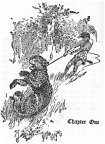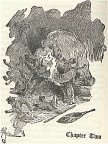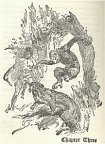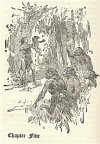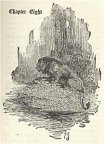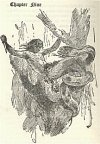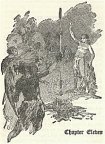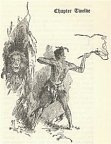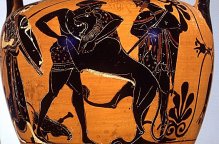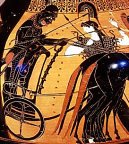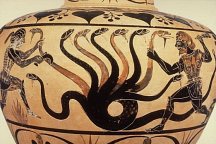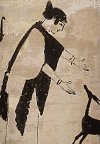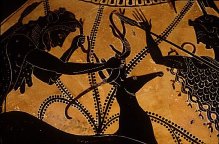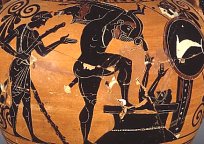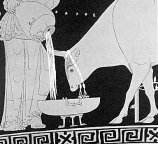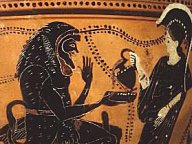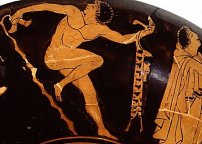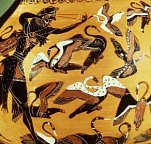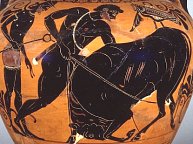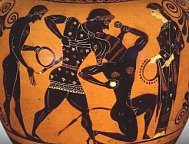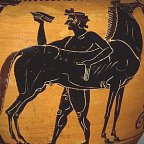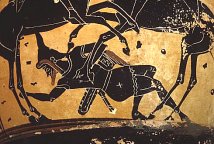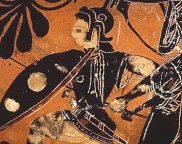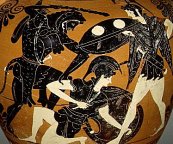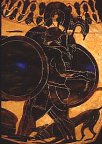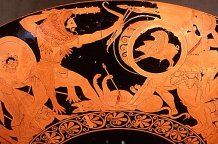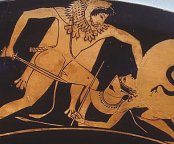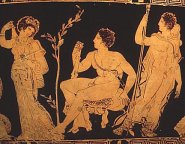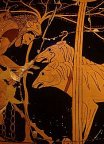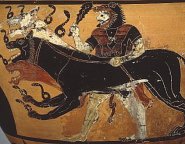
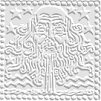


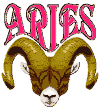
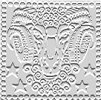

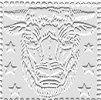

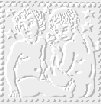


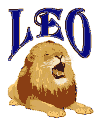
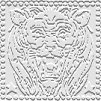

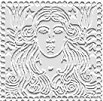

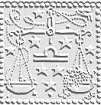
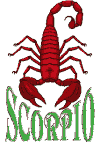
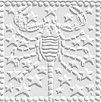
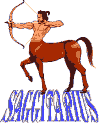


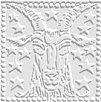
|
When we are through indulging in realms of magic and are ready to
get down to the serious business of literary criticism, we find that Edgar
Rice Burroughs has presented us with a unique set of epic tales of a sun-god
in his youthful lunar phase. For whatever other reasons one may present
for the stories numbering twelve, make no mistake in thinking that Burroughs
was not completely aware that he was rewriting the classical twelve labors
for his ape-man with the model of Hercules clearly in mind.
Each of the labors of course refers to a specific sign of the zodiac,
and a deeper study than this one may show them to match the cycle point
for point. If they do not fit neatly into the Hercules myth with
equal ease, it is only because Burroughs was interested in developing his
larger symbolic theme of showing how the young Tarzan was in the process
of discovering his totem animal, Numa, the male lion. (A more complete
treatment of these themes can be found in my article, "The Soul of the
Lion", a study of the lion symbol throughout all of the books in the Tarzan
series.)
If my theory is correct, we should expect to find Sabor and Sheeta
stories before the Numa ones in this series of Tarzan's initiation tales
written just after the great account of the initiation of a hero in
The Son of Tarzan. Sabor is a female lion, which represents the
feminine side of the symbol complex, and overcoming the Magna Mater necessary
for the young man as a stepping stone to his eventual full hero status.
1. In the first story, Tarzan saves Teeka, his first ape love,
from Sheeta, the leopard (a classic symbol of unbridled sexual passion)
-- and given the nature of the story -- a perfect symbolistic
fit. (As in The Son of Tarzan there are other big issues
happening, but for sake of brevity this article must stay focused on the
lion.)
2. A Tantor story - - the elephant is a symbol of strength,
axis of the universe, clouds, wisdom, moderation, eternity, pity
(Cirlot, A Dictionary of Symbols, 92). The aspect is more relaxed,
or more ethereal; it is an eternal friendship Burroughs employs over and
over to express peace and contentment - - quiet moments before the storm.
3. Tarzan saves Teeka's balu from a leopard - - the old passionate
attachment is vindicated.
4. The God of Tarzan - - Tarzan, "muscled like Numa, the lion"
(82) slays the Buffalo-headed witch-doctor "god," then running and
growling like Numa himself (89-90) he spares Mbonga out of pity (91)
and saves Teeka from a snake in the garden of Eden.
5. Tarzan and the Black Boy - - Visions of Numa struggling
in his rope thrilled the ape-man (101). This is true because Numa's
capture or death would signal the coming of his manhood. Tarzan viewed
the suffering of Sabor and her dead cubs (127) which confirms the
waning Magna Mater image. Burroughs gets involved with an "association
of ideas" (128) around motherhood, but we have to read the dead lion cub
as the ending of Tarzan's youth to get the complete picture. Is Tarzan
to have a balu, like a woman? He saves his mock-child (Tibo) from
Numa, killing a male lion with his spear & knife. Was this his first
kill of Numa? Well, it's the earliest recorded if we read Tarzan's
life as history rather than fiction, thus the first related to his male-hero
symbolism.
6. Tarzan drinks water with Numa - - reflecting the great scene
in Jewels (142). It is a scene of confirmation of his male-hero
status. He returns to his balu's mother, but leaves without slaying
her. A lion coughs and moans under his tree all night long.
There is no going back now. He is a male-lion-hero. (A comic
kitty cat meowing at Lord Greystoke's estate in far-off England mirrors
the situation) (146) Then, he saves little lost Tibo from the witch-doctor
Bukawai's hyenas.
7. The End of Bukawai - - A jungle storm is convincingly compared
to lions on the hunt (179). Tarzan ties Bukawai to feed his own hyenas
- - like the infamous Untamed scene with the starving lion and the German.
8. Numa kills a female mangani, and Tarzan and the apes steal
the body back (204). They post sentries. Tarzan is almost killed
by the apes when he (Hercules-like) dresses in a lion-pelt. He was
not yet the lord of the jungle, king of the apes (196).
9. The Nightmare - - Tarzan eats bad elephant meat, (devouring
the symbol of friendship and peace becomes taboo) then dreams of a climbing
lion (219). He sees a real lion to make a comparison between
dream symbols and reality (222). Tarzan had dreamed his first dream
- - and Burroughs takes advantage of the situation to ask many questions,
which demonstrates that some of the lion sequences in the Tarzan Series
are to be considered dream sequences. He dreams of Histah (226).
Tarzan thinks he is dreaming of an attack by Bolgani, the gorilla, but
it is real.
"If this was a sleep adventure, what then
was reality? How was he to know the one from the other? How
much of all that had happened in his life had been real and how much unreal?
(233)
We might read the situation as the division between the real and the
unreal being presented to Tarzan for the first time, whereas, he actually
is coming to a sense of the real. His life before this was all in
dream-time. He is actually on the brink of leaving his Edenic state
into a new world of reality rather than the other way around. His
status as an Adam who lives in perfect harmony with Nature and the animals
is being challenged.
10. Battle for Teeka - - It is a fight with an ape; no lions
are involved. Another lion here would have been simply amazing and
great support to the lion symbol theory, but enough is enough. What
is happening here? Even my second paper does not make it clear to
me.
11. Jungle Joke - - Tarzan puts Rabba Kega, a witch doctor,
into lion-cage-trap where he is killed by a Numa. He performs the
hiding under a lion skin trick again, (as in story # 8) but pulls a switch
and frees a real lion in the village. Lion tricks are initiation
rites made up by Tarzan to fix his lion totem. Burroughs' comment
placed into the mouth of one of the natives proves the point .
"'He changed himself from a lion to a man,
and back again into a lion,"' whispered another" (292).
(By the way, the witch doctor, Rabba Kega, quite obviously got his name
from Kabba Rega, the king of Unyoro mentioned by Henry M. Stanley in his
Through the Dark Continent . (Stanley 346)
12. Tarzan Rescues the Moon - - The lion is a jungle night
hunter in ERB (295). While lions surround a group of natives huddled
behind a boma at night, Burroughs paints a great picture of his lion
symbol. We see the lion's eyes, a constellation of fierce stars in
the jungle night, and they are compared with the stars overhead, as the
flashing torches of the frightened natives whirl and spin through the great
darkness that lies in between. Eventually, the lions feed upon the
blacks, but Tarzan is bored. It is he who finally recognizes the
stars as lions eyes (303). Numa hunts above the trees (304).
And in a crowning moment, "a meteor fell, blazing a flaming way through
the sky. "Look!" cried Tarzan. "Goro has thrown a burning branch
at Numa" (304). It is after this revelation that Tarzan speaks
his "it is good to be alive" credo, and it is most appropriately spoken
to Tantor, the symbol of eternal peace.
"Tantor, " he said, "it is good to be alive.
It is good to lie in the cool shadows. It is good to look upon the
green trees and the bright colors of the flowers - - upon everything which
Bulamutumumo has put here for us . . . All that
He asks is that we be strong enough or cunning enough to go forth and take
it. Yes, Tantor, it is good to live. I should hate to die"
(308).
Numa, the lion does not approach Tantor/Tarzan, for they are etched
in eternity now. He spares a black - - a sign of his man-pity to
come (315). Then the great Numa of the skies is slain by Tarzan,
a great scene that rounds out the series of stories and the lion symbol
in epic proportions (318).
"Raising his face to the moon, Tarzan shrilled
forth his hideous challenge. Faintly and from afar came the roar
of an answering lion. The apes shivered. Numa of the skies
had answered Tarzan" (318).
An eclipse of the moon is turned into an occasion of symbolistic epiphany.
When one finally sees what Burroughs was doing with this powerful series
of twelve stories, it raises his stature as a writer of great literature
as well as entertaining tales.
"At last came a cry from Taug.'Look!
Look!' he screamed. 'Numa is killed. Tarzan has killed Numa"
(319).
In the tenth labor of Hercules, the hero shoots an arrow at the sun.
"Helius beamed down upon Heracles who, finding
it impossible to work in such heat, strung his bow and let fly an arrow
at the god" (Graves, Greek Myths 133).
Graves tells us in one of his copious footnotes that:
"The arrow which Heracles shot at the noon-day
sun will have been one discharged at the zenith during his coronation ceremony"
(Graves, Greek Myths 144).
Although the lion is a solar symbol, these are the night tales of Tarzan,
dream-like memories of youth, so the Moon-Lion at the end is entirely suitable.
Tarzan has performed the twelve lunar labors, overcoming both the Magna
Mater and her symbolic planet. And although he does not achieve final
unity with his totem lion until the opening chapters of Tarzan and the
Golden Lion, these stories provide us with the arcana of Tarzan's youth
in the most spectacular fashion. There is really nothing else like
it in all of Burroughs. |

![]()
![]()
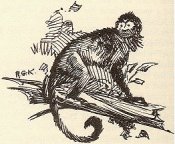
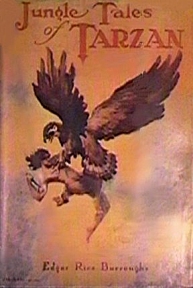
![]()
![]()
























